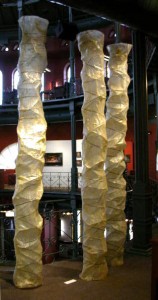Charles Steckler: Stage Design
A Retrospective Exhibition
 The exhibition Charles Steckler: Stage Design presents photographs, models, sketches, and props from over thirty years of the designer’s work. Exhibiting these artifacts in a gallery setting emphasizes their visual artistry and strength as aesthetic objects. Indeed, when viewed in terms of aesthetics, Charles Steckler’s designs prove to be exceptional, finely tuned orchestrations of color, line, and space; carefully balanced, skillfully proportioned, and elegantly crafted. Because stage design is a temporal, ephemeral art form, this exhibition provides a rare opportunity to view this designer’s oeuvre in one place, at one time, and the value is twofold: both the breadth of Steckler’s art and the presence of a distinctive style are revealed.
The exhibition Charles Steckler: Stage Design presents photographs, models, sketches, and props from over thirty years of the designer’s work. Exhibiting these artifacts in a gallery setting emphasizes their visual artistry and strength as aesthetic objects. Indeed, when viewed in terms of aesthetics, Charles Steckler’s designs prove to be exceptional, finely tuned orchestrations of color, line, and space; carefully balanced, skillfully proportioned, and elegantly crafted. Because stage design is a temporal, ephemeral art form, this exhibition provides a rare opportunity to view this designer’s oeuvre in one place, at one time, and the value is twofold: both the breadth of Steckler’s art and the presence of a distinctive style are revealed.
Steckler has created designs as diverse and wide ranging in impact as his minimalist Metamorphosis (1998) and his densely packed, multi-textured Tempest (1993). Drawing on the traditions of stage design from the ancient to the modern, as well as the entire history of art from Classical to Contemporary, he is able to move with ease from a design that looks cut from 18th century engravings (Charles the Second, 1994) to a design in which actors share the stage with lasers, mirrors, and projected images (Prometheus Bound, 2001). Designs such as The Government Inspector (1999), The Big Bang (2000), The Tempest (1993), and Do Black Patent Leather Shoes Really Reflect Up?(1993) demonstrate that, when the demands of director, space, and text allow, Steckler has a distinct style of his own. An accomplished collage and assemblage artist, Steckler imbues his best designs with many of the same characteristics that his non-theatrical work possesses: a rhythmic layering of objects which fill the space; harmonies created though pattern and texture; vibrant color; a meticulous attention to surface detail, not to mention structural detail; and always, a playful energy, a sense of joy and pleasure in materials and the forms they take. Indeed, even in more traditional, box set designs such as What the Butler Saw (2002) or Tartuffe (2004), these elements are strongly present.
Charles Steckler’s great skill is his ability to create compositions that are highly complex and utterly harmonious. They are filled with detail yet successfully unified. The vibrant, theatrical colors are skillfully combined to create energetic and balanced palettes. His ability to create a play of shape against shape, and object against void results in the creation of powerful rhythms. Above all, the ebullience and energy embodied in even some of the more serious or spare settings guarantees the viewer’s lasting engagement. The result is an impressive body of work that is enduringly pleasing and challenging, smart and sublime. – Rachel Seligman
Workshops
In conjunction to the exhibit Charles Steckler is teaching a series of workshops with local students from the Studying Arithmetic in Literature (SAIL) Program. These workshops explore the process of stage design with a guided gallery tour and a hands-on activity: each child creates their own environment by building a diorama.
Opening Reception
with Special Theatrical Supplies
Thursday, January 12, 2006
4:30 – 6:30 PM
Nott Memorial